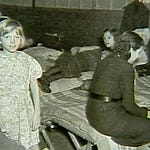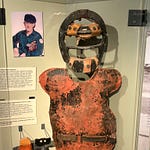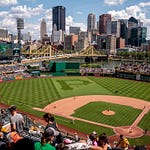Read Part One of Flood to Food Banks here.
By the spring of 1937, the Ohio River had retreated to its banks, but the questions it left behind were harder to contain. Across the valley, local officials and federal administrators began asking what might happen if the same machinery that fed the stranded could be used to feed the poor.
That question found its first real test in Pittsburgh, a city still defined by its mills and smoke. In the months after the flood, the Red Cross and the Works Progress Administration (WPA) turned their emergency kitchens into an experiment. Instead of closing when the waters receded, they stayed open—serving families displaced not by water, but by chronic unemployment. The effort became known informally as the Pittsburgh “trial project.”
The idea spread quickly. Relief experiments cropped up in other cities—St. Louis, Cincinnati, Louisville—each adapting WPA labor and surplus commodities in its own way. None were as formally structured as Pittsburgh’s, but all were feeling their way toward a similar question: how do you feed people once the emergency ends?
But Pittsburgh stood out for its scale and precision. Backed by federal administrators who had cut their teeth on flood relief, the city developed a system for inventorying, storing, and distributing food that could function even when emergency funds dried up.
At its core, the project asked whether public welfare could operate with the efficiency of disaster relief. WPA clerks cataloged household needs; local grocers became distribution partners; surplus commodities from the U.S. Department of Agriculture—flour, beans, lard, canned fruit—were tracked, stored, and rationed according to family size. The Red Cross supplied social workers, and city officials provided warehouses and trucks. Together they built a prototype for what would later be called food security logistics.
The trial wasn’t perfect. Federal funding ebbed with each budget cycle, and the social stigma of “relief food” remained. But the administrative bones of the system—the inventories, supply chains, and coordination among civic and charitable agencies—became a model. The project didn’t design the Surplus Commodities Program, but it mirrored the same principles—standardized inventories, warehouse distribution, and coordinated logistics—that federal policymakers would embrace by 1939.
The Great Flood’s legacy, it turned out, wasn’t only the levees that kept rivers in check—it was the blueprint for a nation learning to feed itself in good times and bad.
And here’s a picture of Secretary of Labor, Frances Perkins, with Pittsburgh steelworkers in 1933.
Now that you’ve read about the Pittsburgh “trial project” and its sister cities, test what you know about how these experiments evolved into the modern food-bank system in this month’s quiz.
Note to my fantastic new subscribers:
It’s the rare person who can answer all ten trivia questions without any prep. I couldn’t answer them without a significant amount of research, either! Do your best and enjoy learning something new.
QUESTIONS:
Each question has one correct answer, found in the footnotes.
1. What made Pittsburgh the ideal testing ground for the “trial project?”1
A. It had strong labor unions and civic coordination
B. It had an existing network of flood-relief warehouses and staff
C. It was home to one of the nation’s largest steelworker populations
D. It was the operational capital of the New Deal’s relief agencies in the East
2. Which New Deal administrator was known for saying, “People don’t eat in the long run—they eat every day?”2
A. Harold Ickes
B. Eleanor Roosevelt
C. Harry Hopkins
D. Henry Wallace
3. Which prominent women helped shape Pittsburgh’s approach to relief work?3
A. Frances Perkins
B. Eleanor Roosevelt
C. Mary McLeod Bethune
D. All of the above
4. What immediate challenge did Pittsburgh face once the floodwaters receded?4
A. Contaminated food supplies
B. Unemployment in the mills
C. Housing shortages in the suburbs
D. Labor strikes in city services
5. Which local partner helped the WPA convert emergency kitchens into year-round distribution centers?5
A. The Heinz Company
B. The City Department of Public Welfare
C. Carnegie Steel
D. The Allegheny Conference on Community Development
6. What role did the Red Cross play in Pittsburgh’s trial project?6
A. Operated soup kitchens independently
B. Supplied social workers and coordinated volunteers
C. Focused solely on medical care
D. Distributed industrial food waste to the poor
7. What was unique about Pittsburgh’s data collection?7
A. It used punch-card tabulators from local mills
B. WPA clerks tracked every meal and household served
C. It relied on volunteer recordkeepers from churches
D. All records were destroyed after the project ended
8. What type of food filled Pittsburgh’s relief warehouses?8
A. Locally grown produce and dairy
B. Imported European goods
C. USDA surplus commodities
D. Restaurant leftovers donated by civic clubs
9. Why did some Pittsburgh residents resist the program?9
A. Fear of socialism and stigma around “relief food”
B. Dietary restrictions in immigrant communities
C. Disputes between union and non-union households
D. Concerns about federal control of local farms
10. What enduring lesson came from Pittsburgh’s “trial project?”10
A. Feeding systems could be industrialized like steel
B. Charity worked better than coordination
C. Flood control was more important than hunger relief
D. Relief should be handled only by private agencies
Up next in Part Three of Flood to Food Banks: How Did the U.S. Government End Up in the Grocery Business?
Intermission
Here’s a great documentary about the Great Flood of 1937 in Pittsburgh, which peaked at 46 feet.
The segment featured an interview with Dr. H. Ward Ewalt, a Pittsburgh optometrist who filmed the flood and the damage it created around the city. It includes footage of the flood in downtown Pittsburgh, the J&L mill in Hazelwood, Lawrenceville, Manchester, Etna, Turtle Creek, Bellevue and Millvale. Ewalt passed away in 1995 after a long career in optometry.
ANSWERS
A. It had strong labor unions and civic coordination
Pittsburgh’s mix of organized labor, active city government, and experienced relief workers made it a natural laboratory for coordinated public welfare—while the true operational hub of New Deal relief was New York City, not Pittsburgh.
C. Harry Hopkins
Hopkins’s plainspoken realism guided the WPA’s work and welfare philosophy. His words echoed through projects like Pittsburgh’s, where relief meant solving hunger day by day. Here’s a video with David Roll, author of “The Hopkins Touch” talking about Hopkins’ life and legacy. Roll observed: Roosevelt relied on Harry Hopkins not only to manage relief at home but later to negotiate trust abroad—proof that the skills of feeding people and forging alliances often overlapped.
D. All of the above
Perkins created the policy framework that made the WPA possible. Roosevelt promoted women’s civic roles, and Bethune led the WPA’s National Youth Administration Negro Division, ensuring Black families and youth were included in the nation’s recovery.
A. Contaminated food supplies
Flooded warehouses and spoiled goods forced officials to rethink refrigeration, sanitation, and inspection—cornerstones of later food-bank logistics.
B. The City Department of Public Welfare
The department supplied buildings, clerical staff, and trucks, integrating federal and city systems in one coordinated relief network. Full disclosure, I would have guessed The Heinz Company because I’ve been brainwashed by the history museum that bears its name. Silly me.
B. Supplied social workers and coordinated volunteers
Red Cross caseworkers helped register families, track nutrition, and ensure federal food aid reached those most in need.
B. WPA clerks tracked every meal and household served
Detailed ledgers turned social care into measurable infrastructure—a precedent for later federal reporting standards in welfare programs.
C. USDA surplus commodities
Flour, beans, lard, rice, and canned fruit shipped by rail from the U.S. Department of Agriculture’s surplus stores formed the foundation of the program.
A. Fear of socialism and stigma around “relief food”
Many working-class families equated accepting government groceries with personal failure—a tension that still shadows food assistance today.
A. Feeding systems could be industrialized like steel
The city that forged metal learned to forge compassion—organizing storage, transport, and distribution with factory-level precision.











